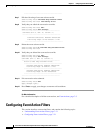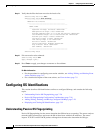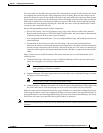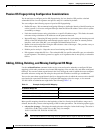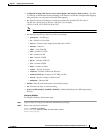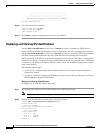
7-26
Cisco Intrusion Prevention System CLI Sensor Configuration Guide for IPS 7.1
OL-19892-01
Chapter 7 Configuring Event Action Rules
Configuring OS Identifications
Step 11 Verify that the filter has been moved to the inactive list.
sensor(config-eve-fil)# exit
sensor(config-eve)# show settings
-----------------------------------------------
INACTIVE list-contents
-----------------------------------------------
-----------------------------------------------
NAME: name1
-----------------------------------------------
signature-id-range: 900-65535 <defaulted>
subsignature-id-range: 0-255 <defaulted>
attacker-address-range: 0.0.0.0-255.255.255.255 <defaulted>
victim-address-range: 0.0.0.0-255.255.255.255 <defaulted>
attacker-port-range: 0-65535 <defaulted>
victim-port-range: 0-65535 <defaulted>
risk-rating-range: 0-100 <defaulted>
actions-to-remove: <defaulted>
filter-item-status: Enabled <defaulted>
stop-on-match: False <defaulted>
user-comment: <defaulted>
-----------------------------------------------
-----------------------------------------------
sensor(config-eve)#
Step 12 Exit event action rules submode.
sensor(config-eve)# exit
Apply Changes:?[yes]:
Step 13 Press Enter to apply your changes or enter no to discard them.
For More Information
• For the procedure for configuring event action variables, see Adding, Editing, and Deleting Event
Action Variables, page 7-11.
• For a detailed description of the event actions, see Event Actions, page 7-5.
Configuring OS Identifications
This section describes OS identifications and how to configure OS maps, and contains the following
topics:
• Understanding Passive OS Fingerprinting, page 7-26
• Passive OS Fingerprinting Configuration Considerations, page 7-28
• Adding, Editing, Deleting, and Moving Configured OS Maps, page 7-28
• Displaying and Clearing OS Identifications, page 7-32
Understanding Passive OS Fingerprinting
Passive OS fingerprinting lets the sensor determine the OS that hosts are running. The sensor analyzes
network traffic between hosts and stores the OS of these hosts with their IP addresses. The sensor
inspects TCP SYN and SYNACK packets exchanged on the network to determine the OS type.





